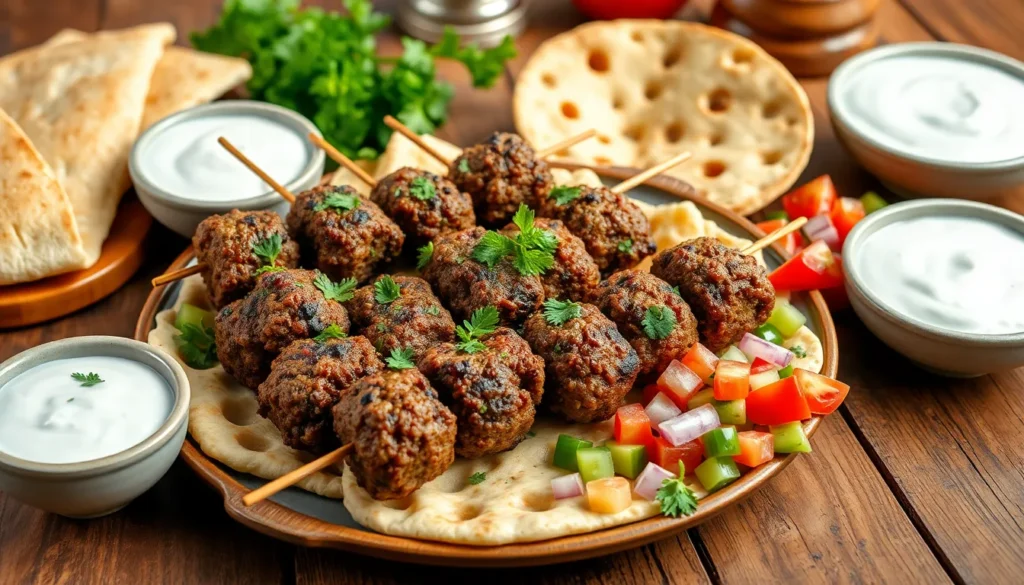We’ve fallen head over heels for this ground beef kofta recipe that transforms simple ingredients into something absolutely spectacular. These Middle Eastern spiced meatballs pack incredible flavor with aromatic herbs and warm spices that’ll make your kitchen smell like heaven. Whether you’re grilling them outdoors or cooking them in a skillet, kofta delivers that perfect combination of juicy meat and bold seasoning that keeps everyone coming back for more.
What we love most about kofta is how effortlessly elegant it feels while being surprisingly simple to make. The secret lies in the perfect blend of fresh parsley, mint, and traditional spices that create layers of flavor you won’t find in ordinary meatballs. We’ve perfected this recipe to give you tender, perfectly seasoned kofta every single time.
Ready to elevate your dinner game? This ground beef kofta will become your new go-to recipe for impressive weeknight dinners and weekend gatherings alike.
What You’ll Need
We’ve organized our ingredient list to make your ground beef kofta preparation seamless and efficient. Our recipe calls for common pantry staples alongside fresh herbs that create the signature Middle Eastern flavor profile.
For the Kofta:
- 1 pound ground beef (80/20 blend works best)
- 1 medium yellow onion, finely minced
- 3 garlic cloves, minced
- 1/4 cup fresh parsley, finely chopped
- 2 tablespoons fresh mint, finely chopped
- 1 teaspoon ground cumin
- 1 teaspoon ground coriander
- 1/2 teaspoon paprika
- 1/2 teaspoon ground cinnamon
- 1/4 teaspoon cayenne pepper
- 1 teaspoon salt
- 1/2 teaspoon black pepper
- 1 tablespoon olive oil
Essential Equipment:
- Large mixing bowl
- Sharp knife for mincing herbs
- Cutting board
- Measuring spoons and cups
- Grill or large skillet
- Metal or wooden skewers (if grilling)
Optional Garnishes:
- Fresh mint leaves
- Lemon wedges
- Greek yogurt or tzatziki
- Warm pita bread
- Diced tomatoes and cucumbers
We recommend using 80/20 ground beef because the fat content keeps our kofta moist and flavorful during cooking. Fresh herbs make a important difference in taste compared to dried alternatives. Our spice blend creates layers of warmth without overwhelming heat.
Metal skewers work better for grilling because they conduct heat and cook the meat more evenly. Wooden skewers need soaking in water for 30 minutes before use to prevent burning.
Ingredients
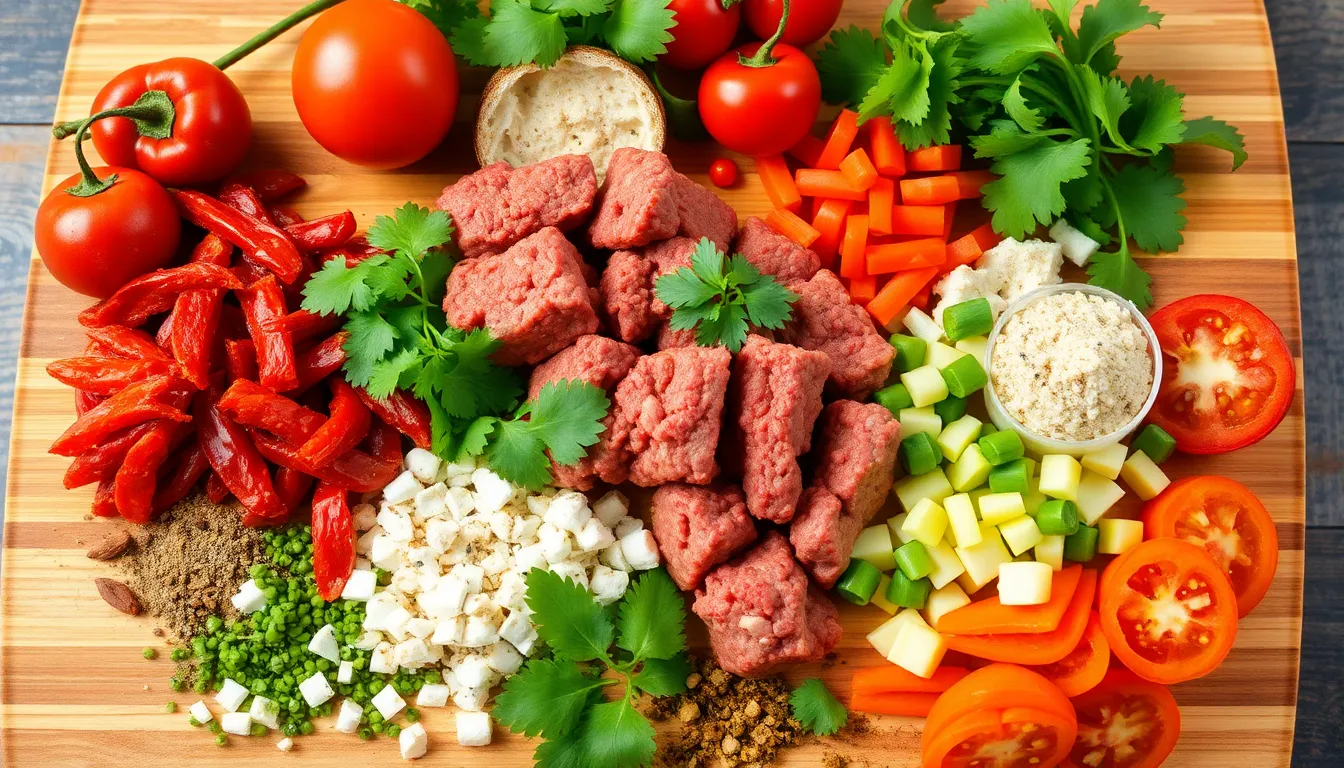
We’ve carefully selected each ingredient to create the perfect balance of flavors and textures in our ground beef kofta. Our recipe combines fresh aromatics with warm Middle Eastern spices for an authentic taste.
For the Kofta
- 2 pounds ground beef (80/20 blend recommended for optimal moisture)
- 1 medium yellow onion, finely chopped or processed
- 4 garlic cloves, minced
- 1 cup fresh parsley, finely chopped
- 2 tablespoons fresh mint, minced (optional but recommended)
- 2 teaspoons ground cumin
- 1 teaspoon ground coriander
- 1 teaspoon kosher salt
- ½ teaspoon black pepper
- ½ teaspoon sweet paprika
- ¼ teaspoon ground allspice
- ¼ teaspoon ground cinnamon
- Pinch of ground cardamom
- ¼ teaspoon red pepper flakes (optional for heat)
For the Sauce (Optional)
- 1 cup Greek yogurt
- 1 medium cucumber, peeled and finely diced
- 2 garlic cloves, minced
- 2 tablespoons fresh lemon juice
- 1 tablespoon extra virgin olive oil
- 1 tablespoon fresh dill, chopped
- Salt and pepper to taste
Equipment and Tools

Preparing authentic ground beef kofta requires the right tools to achieve that perfect texture and flavor our recipe promises. We’ve found that having the proper equipment makes the difference between good kofta and exceptional Middle Eastern meatballs that rival your favorite restaurant.
Large Mixing Bowl serves as our foundation for combining all ingredients thoroughly. The spaciousness allows us to mix the ground beef with herbs and spices without creating a mess on our countertops.
Food Processor or Box Grater becomes essential for achieving finely minced aromatics. We pulse onion, parsley, and garlic in the food processor until they reach that perfect fine texture that blends seamlessly into our meat mixture. A box grater works as an alternative when a food processor isn’t available.
Sharp Knife and Cutting Board handle our initial prep work efficiently. We use these tools for rough chopping before transferring ingredients to the food processor or for any additional garnish preparation.
Wooden or Metal Skewers shape our kofta into those traditional kebab forms. Metal skewers conduct heat better and create more even cooking, while wooden skewers need soaking in water for 30 minutes to prevent burning during grilling.
Grill, BBQ, or Grill Pan provides the cooking surface that gives our kofta that distinctive smoky flavor. A grill pan works perfectly for indoor cooking when outdoor grilling isn’t possible.
Kitchen Towel or Cheesecloth helps remove excess moisture from grated onion. This optional step prevents our kofta mixture from becoming too wet, ensuring better binding and cooking results.
| Equipment | Purpose | Essential Level |
|---|---|---|
| Large Mixing Bowl | Combining ingredients | Essential |
| Food Processor/Grater | Mincing aromatics | Essential |
| Sharp Knife | Prep work | Essential |
| Skewers | Shaping kofta | For kebab style |
| Grill/Grill Pan | Cooking | Essential |
| Kitchen Towel | Moisture removal | Optional |
Instructions
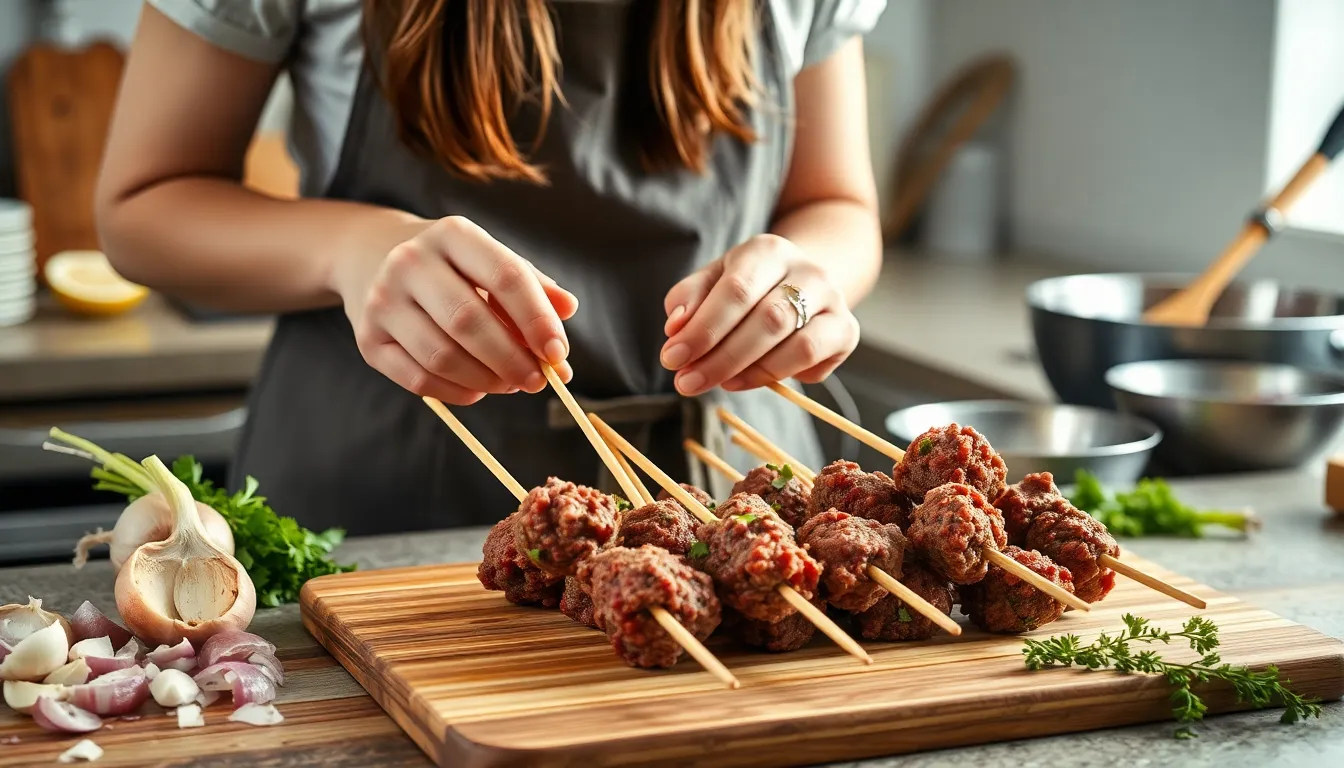
We’ll walk through creating these aromatic ground beef kofta step by step to ensure perfect results every time. Our method focuses on building layers of flavor while maintaining the ideal texture.
Prep the Meat Mixture
We start by processing our aromatics in a small food processor until finely chopped. Add the onion, garlic, and fresh parsley to the processor and pulse until well minced but not pureed.
Transfer the processed aromatics to our large mixing bowl with the ground beef. We season the mixture with ground cumin, coriander, cinnamon, salt, and pepper.
Using clean hands, we gently combine all ingredients until just mixed. We avoid overworking the meat to maintain tenderness. For traditional kabobs, we grate the onion instead of chopping it to keep the mixture moist and help bind the ingredients.
Cover the bowl and refrigerate the meat mixture for at least one hour. This resting period allows the flavors to meld and makes shaping much easier.
Shape the Kofta
We remove the chilled mixture from the refrigerator and divide it into equal portions. Each portion should form an oblong shape approximately 1 inch thick for kebabs.
For skewer preparation, we soak wooden skewers in water for 30 minutes to 1 hour before using. This prevents burning during cooking.
We mold each portion around the soaked skewers, pressing gently to ensure the meat adheres well. The kofta should be evenly distributed along the skewer with no gaps.
Alternatively, we can shape the mixture into meatballs if preferred. Roll each portion between our palms to create uniform spheres about 1.5 inches in diameter.
Cook the Kofta
Grill Method: We preheat our grill or grill pan to medium-high heat and brush the grates with oil. Place the kofta on the grill and cook for 4-6 minutes per side until they reach an internal temperature of 165°F.
For kabobs specifically, we cook them about 2 minutes per side on medium heat, turning carefully to maintain their shape.
Oven Method: We preheat our oven to 350°F and line a baking sheet with parchment paper. Arrange the kofta on the prepared sheet and bake for 18-30 minutes depending on size, turning halfway through for even cooking.
We can broil the kofta for 2-3 minutes at the end of baking to achieve a golden, crispy exterior. This optional step adds excellent texture contrast to our finished dish.
Cooking Methods
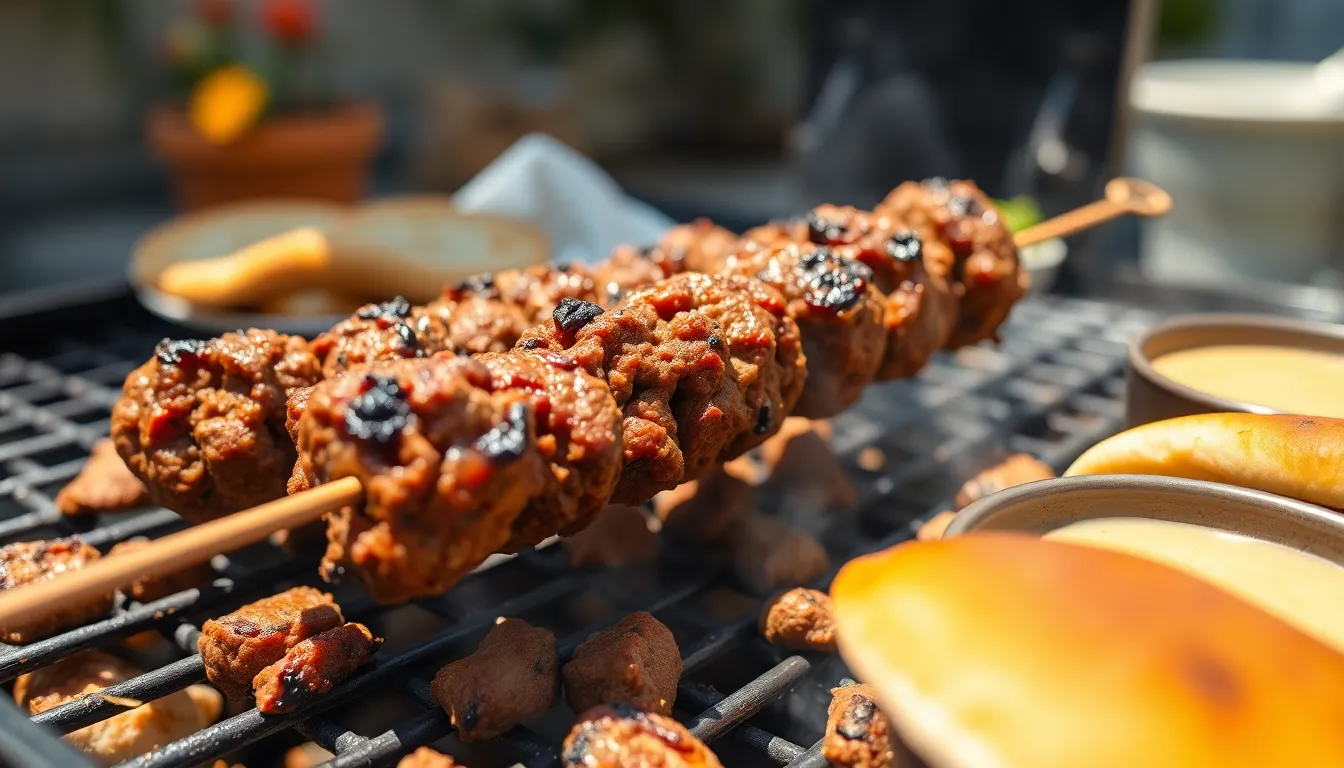
Ground beef kofta offers remarkable versatility through multiple cooking techniques that each deliver distinct textures and flavors. We can achieve perfectly cooked kofta using grilling, pan-frying, or baking methods depending on our kitchen setup and preferences.
Grilling Method
We recommend preheating our grill to medium-high heat and oiling the grates thoroughly to prevent sticking. Place the kofta skewers on the grill and cook for about 4 minutes on one side before turning and grilling for another 3-4 minutes. The total grilling time reaches approximately 7-8 minutes for skewered kofta.
For kofta shaped without skewers, we grill them uncovered for 12-14 minutes while turning occasionally. Our internal temperature must reach 160°F (71°C) to ensure proper doneness and food safety. The high heat creates beautiful char marks while sealing in the aromatic spices and juices.
We serve grilled kofta immediately while hot, accompanied by warm pita bread and tahini sauce for the most authentic experience.
Pan-Frying Method
Heat a small amount of oil in our pan over medium-high heat before adding the kofta. We avoid overcrowding the pan to ensure even browning on all sides. Cook each side for approximately 4-5 minutes, turning carefully to prevent breaking the delicate meat mixture.
Our kofta logs or patties develop a golden-brown crust while maintaining their tender interior texture. We continue cooking until the internal temperature reaches 160°F, which typically takes 8-10 minutes total cooking time. This method works exceptionally well when outdoor grilling is not available.
The pan-frying technique allows us to control the heat more precisely and creates an evenly cooked exterior with concentrated flavors.
Baking Method
We preheat our oven to 350-400°F (175-205°C) and lightly oil a baking sheet to prevent sticking. Place the shaped kofta on the prepared baking sheet with adequate spacing between each piece. Bake for 15-18 minutes, turning halfway through if we desire more even browning on all sides.
| Cooking Method | Temperature | Time | Internal Temp |
|---|---|---|---|
| Grilling (skewered) | Medium-high heat | 7-8 minutes | 160°F |
| Grilling (no skewer) | Medium-high heat | 12-14 minutes | 160°F |
| Pan-frying | Medium-high heat | 8-10 minutes | 160°F |
| Baking | 350-400°F | 15-18 minutes | 160°F |
This baking method produces evenly cooked kofta with consistent results every time. We find this technique ideal when preparing larger quantities or when we want a hands-off cooking approach. The oven method ensures our kofta maintains its shape while developing the proper texture and doneness throughout.
Serving Suggestions

We recommend serving your perfectly cooked ground beef kofta with warm pita bread and creamy tzatziki sauce for an authentic Mediterranean experience. The traditional tzatziki combines Greek yogurt with grated cucumber, minced garlic, fresh lemon juice, and aromatic mint or dill to create a cooling complement to the warm spiced meat.
Classic Middle Eastern dips elevate the entire meal when paired alongside our kofta. We suggest offering hummus and baba ganoush as additional accompaniments that guests can enjoy with the tender meat. These protein-rich dips provide contrasting textures and flavors that enhance each bite.
Rice serves as an excellent foundation for this flavorful dish. We prefer white rice for traditional presentations, though brown rice adds nutty depth and cauliflower rice works beautifully for low-carb dining preferences. Each grain option absorbs the aromatic juices from the kofta while providing satisfying substance.
Fresh vegetables bring bright contrast to the rich, spiced meat. We always include sliced cucumber, ripe tomatoes, and thinly cut red onion for their crisp textures and clean flavors. These raw vegetables cut through the warmth of cumin and other spices while adding essential freshness to every plate.
Mediterranean salads create balanced, nutritious meals when served with our kofta. We particularly enjoy quinoa mixed with roasted vegetables as a wholesome side that complements the protein without overwhelming the dish’s Middle Eastern character. Roasted vegetables alone also work wonderfully for lighter presentations.
Summer barbecue gatherings become memorable when we serve these aromatic kofta kebabs as the centerpiece. The dish works equally well for casual weeknight dinners when time matters but flavor cannot be compromised. Each serving delivers substantial protein while maintaining the vibrant taste profile that makes this traditional recipe so appealing.
Storage and Make-Ahead Tips
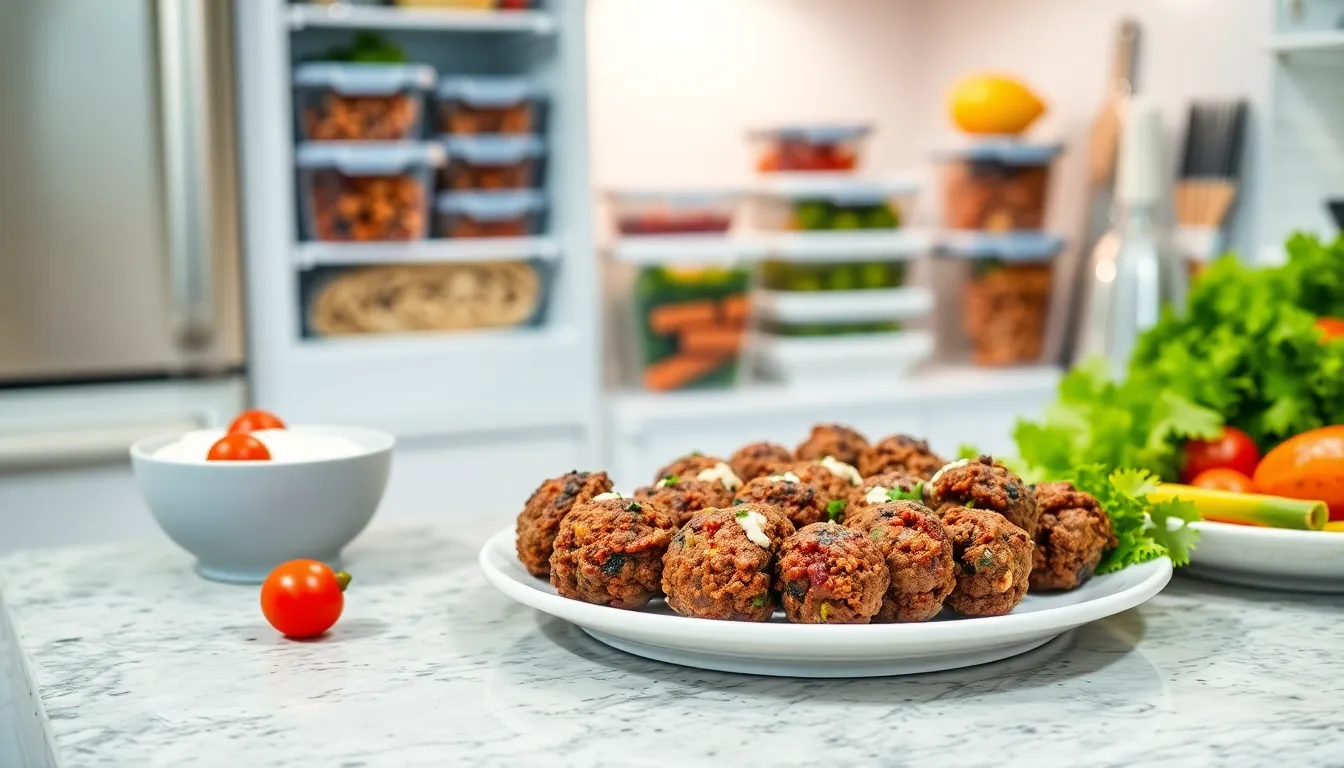
We understand that meal planning and proper storage are essential for enjoying our ground beef kofta recipe at its best. These storage and preparation strategies help maintain the dish’s exceptional flavor and texture while making it convenient for busy schedules.
Storing Leftovers
Store our cooked beef kofta kebabs in an airtight container in the refrigerator for optimal freshness. The leftovers maintain their quality for 3 to 6 days when properly stored according to food safety standards.
We recommend checking for any signs of spoilage before reheating the stored kofta. Always reheat the kebabs thoroughly to ensure food safety and the best eating experience.
For reheating, we suggest using a microwave, toaster oven, or conventional oven set to 350°F until the kofta is heated through. The kebabs may become slightly drier upon reheating, so serving them with tzatziki sauce or another complementary sauce enhances their moisture and flavor.
Make-Ahead Instructions
Our ground beef kofta mixture can be prepared up to one day in advance for convenient meal planning. Simply cover the prepared mixture and store it in the refrigerator until ready to shape and cook.
We also recommend shaping the mixture into kebabs ahead of time and storing the uncooked kofta in an airtight container or freezer bag. This approach allows for quick cooking when needed and maintains the kebabs’ shape and seasoning.
For longer storage, the uncooked kofta mixture freezes exceptionally well for up to six months when tightly sealed in freezer-safe containers. Press out excess air from freezer bags to prevent freezer burn and maintain optimal quality.
Cooked kofta kebabs can also be frozen for future meals. Allow the cooked kebabs to cool completely before placing them in freezer-safe airtight bags or containers for up to three months.
We always ensure our kofta kebabs reach an internal temperature of 160°F when cooking for both safety and optimal texture. When using frozen uncooked kofta, thaw the kebabs completely in the refrigerator before grilling or cooking as directed in our recipe.
Recipe Variations
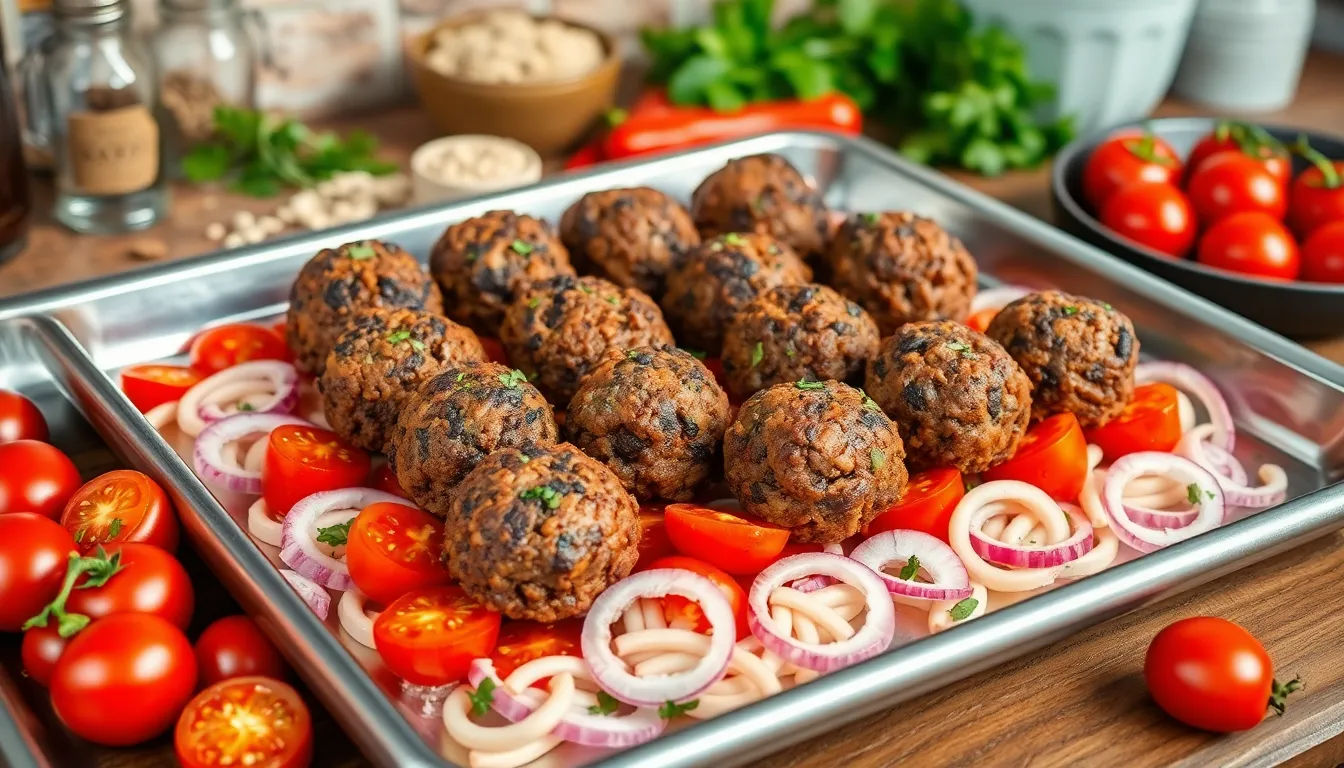
Our ground beef kofta recipe adapts beautifully to different preferences and cooking styles. We’ve discovered that meat selection significantly impacts the final flavor profile of this beloved Middle Eastern dish.
Meat Combinations
Ground lamb creates the most traditional kofta experience with its rich distinctive taste. We recommend combining equal parts ground beef and ground lamb for optimal results that balance flavor depth with accessibility. This 50/50 blend delivers the authentic taste while maintaining the familiar texture that ground beef provides.
| Meat Combination | Flavor Profile | Best For |
|---|---|---|
| 100% Ground Beef | Mild and familiar | Weeknight dinners |
| 50% Beef + 50% Lamb | Rich and traditional | Special occasions |
| 100% Ground Lamb | Intense and authentic | Traditional preparations |
Cooking Method Variations
Sheet pan kofta offers exceptional convenience for feeding larger groups. We prepare this version by arranging the shaped kofta over a bed of cherry tomatoes and sliced red onions on a baking sheet. The vegetables release their juices during cooking while creating a natural sauce that infuses the meat with additional flavor.
Our tomato-lemon sauce enhances the sheet pan method beautifully. We combine 2 tablespoons tomato paste with 1/4 cup water and 2 tablespoons fresh lemon juice before pouring it over the arranged kofta and vegetables. Baking at 400°F for 25 minutes produces tender kofta with caramelized vegetables.
Spice Blend Modifications
Different spice combinations create unique regional variations of this classic dish. We often adjust the heat level by varying cayenne pepper and red pepper flakes according to preference.
Our Mediterranean blend emphasizes oregano and sumac for a tangy brightness. Middle Eastern versions feature more prominent cumin and coriander notes. We sometimes add a pinch of cinnamon or allspice for warmth that complements the meat beautifully.
Serving Style Adaptations
Kofta meatballs work wonderfully when you prefer not to use skewers. We shape the mixture into 1.5-inch balls and pan-fry them until golden brown on all sides. This variation pairs perfectly with rice dishes or pasta.
Burger-style kofta patties create an excellent fusion option for casual dining. We form larger flat patties and grill them like traditional hamburgers. These work exceptionally well in pita pockets with fresh vegetables and tzatziki sauce.
Tips for Perfect Kofta
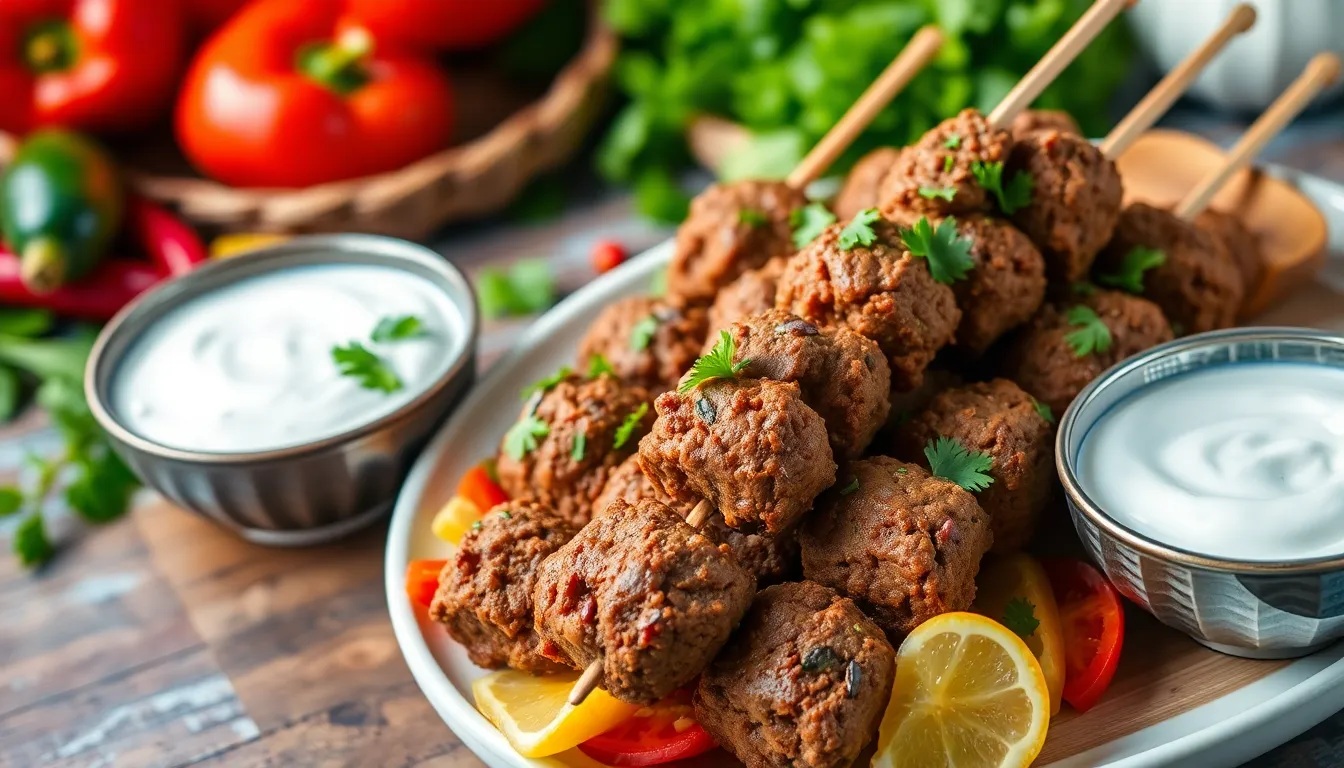
Creating exceptional ground beef kofta requires attention to several key techniques that we’ve refined through extensive testing. Our experience with this Middle Eastern favorite has taught us that success lies in the details.
Meat Selection and Blending
We recommend using a combination of ground beef and lamb for superior flavor and tenderness. The ideal ratio combines 1.5 pounds of ground beef with 0.5 pounds of ground lamb to achieve that authentic Middle Eastern taste profile. Ground beef alone works well but adding lamb elevates the dish significantly.
Texture Preparation
Finely mincing your aromatics makes all the difference in kofta quality. We pulse onion, garlic, and herbs in a food processor to ensure even distribution throughout the meat mixture. This technique prevents large chunks that can cause the kofta to fall apart during cooking.
Flavor Development Through Resting
Refrigerating the mixture for at least 30 minutes to overnight allows flavors to meld completely. We’ve found that this resting period also makes shaping much easier since the mixture firms up considerably. The longer resting time produces more cohesive and flavorful results.
Shaping Techniques
Pressing the meat firmly onto skewers prevents the kofta from falling apart during grilling. We wet our hands slightly when shaping to prevent sticking and create smooth surfaces. Form tight cylindrical shapes around metal skewers or create small oval patties for pan-frying.
Temperature Control
| Cooking Method | Temperature | Internal Temp |
|---|---|---|
| Grilling | 450-550°F | 160-165°F |
| Pan-frying | Medium-high | 160-165°F |
| Baking | 400°F | 160-165°F |
Cook kofta thoroughly but avoid overcooking to maintain juiciness. We monitor internal temperature carefully since overcooked kofta becomes dry and tough.
Fresh Ingredient Priority
Using fresh herbs like parsley and mint creates brightness that dried herbs cannot match. We chop fresh herbs finely and add them just before mixing to preserve their vibrant flavors and colors.
Spice Balance
Incorporating warm spices such as cumin, allspice, cinnamon, and cardamom delivers authentic Middle Eastern flavor. We toast whole spices before grinding when possible to intensify their aromatic qualities.
Serving Strategy
Serve kofta with cooling sauces like yogurt or tzatziki to balance the rich meat flavors. Fresh salads and crisp vegetables provide textural contrast that enhances the overall dining experience.
Conclusion
We’ve shared everything you need to create restaurant-quality ground beef kofta at home. This recipe delivers authentic Middle Eastern flavors through simple techniques and readily available ingredients.
The beauty of kofta lies in its versatility – whether you’re grilling for a crowd or preparing a quick weeknight meal you’ll find a cooking method that works perfectly. The make-ahead options and storage tips ensure you can enjoy this flavorful dish whenever the craving strikes.
Your family and friends will be impressed by the aromatic spices and tender texture that make this kofta truly special. We’re confident this recipe will become a regular part of your cooking rotation bringing the vibrant tastes of the Middle East to your dinner table.
Frequently Asked Questions
What is the best meat blend for kofta?
The ideal blend is 80/20 ground beef for optimal moisture, or a 50/50 combination of ground beef and lamb for richer, more traditional flavor. Ground lamb adds authentic Middle Eastern taste, while the beef provides structure and affordability.
How long should I let the kofta mixture rest?
Allow the kofta mixture to rest in the refrigerator for at least 1 hour before cooking. This resting period helps the flavors meld together and makes the mixture easier to shape while preventing it from falling apart during cooking.
What are the best cooking methods for kofta?
Kofta can be grilled over medium-high heat for 7-8 minutes, pan-fried in oil for 8-10 minutes, or baked at 350-400°F for 15-18 minutes. Each method produces different textures, with grilling offering smoky flavor and baking providing even cooking.
How do I prevent kofta from falling apart on the grill?
Ensure the meat mixture isn’t overworked, use metal skewers (or pre-soaked wooden ones), and let the mixture rest before shaping. Form the kofta firmly around skewers and avoid moving them too frequently while cooking.
What should I serve with kofta?
Serve kofta with warm pita bread, tzatziki sauce, hummus, and fresh vegetables like cucumber and tomatoes. Rice options (white, brown, or cauliflower) work well to absorb flavors, and Mediterranean salads create balanced meals.
How long can I store cooked kofta?
Cooked kofta can be stored in the refrigerator for 3-6 days in an airtight container. For longer storage, freeze cooked kofta for up to 3 months or freeze the uncooked mixture for up to 6 months.
Can I make kofta ahead of time?
Yes, you can prepare the mixture a day in advance and refrigerate it. You can also shape the kofta and store them uncooked for quick cooking later, or freeze the shaped kofta for future use.
What internal temperature should kofta reach?
Kofta should reach an internal temperature of 160°F (71°C) to ensure food safety. Use a meat thermometer to check the thickest part of the kofta for accurate temperature reading.
Should I use fresh or dried herbs in kofta?
Fresh herbs like parsley and mint are strongly recommended over dried herbs for better flavor and texture. Fresh herbs provide brighter taste and better moisture content, which enhances the overall quality of the kofta.
What spices are essential for authentic kofta flavor?
Essential spices include ground cumin, coriander, and sweet paprika. These warm spices create the traditional Middle Eastern flavor profile. Garlic and onion are also crucial aromatics that shouldn’t be omitted from the recipe.

